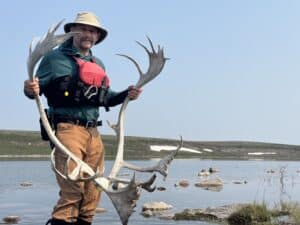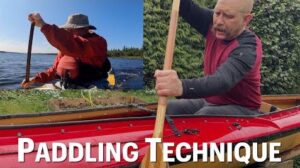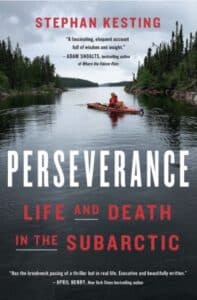I just recently got home from a difficult solo canoe trip in the Canadian Arctic where I didn’t see anyone for weeks. Bears, storms, icebergs and exhaustion, this adventure had it all.
Since I was alone, I had a lot of time to think. A big takeaway was how relevant some aspects of this wilderness stuff were to jiu-jitsu.
Here are the three big lessons I learned from that trip, and how they might apply to YOUR training, even if you have zero interest in canoeing yourself…

Stephan with a Caribou Rack in Nunavut
1, Preventing Injuries
Let’s start with injury-proofing and working around injuries.
Many years ago, I hurt my back at the fire department. When I came home from that shift, I lay down on the floor.
Later I tried to get up, and that movement triggered waves of white-hot agony through my whole body.
I ended up lying on that floor for 24 hours, afraid to move in case I re-aggravated my back.
That injury deviled me for years until I found the right combination of treatments to keep it more or less under control.
My back pain would still flare up from time to time, with Judo throws and paddling being reliable triggers.
For example, on another solo trip, my back regularly knotted in pain so intense I couldn’t sleep, usually after a long days of struggling against the wind.
Needless to say I was worried about this summer’s trip. What if my back gave out and I was unable to continue? Helicopter evacuations in the far North are very expensive and embarrassing.
To minimize the chances of my back injury acting up I did two things…
First, I modified my technique.
As the mileage on your body increases (and especially as you do jiu-jitsu) you HAVE to be pro-active and adapt.
Just as I’ve had to adapt my jiu-jitsu training as I get older I’ve also had to change my paddling style.
(Specifically I’ve started using less body rotation and more body lean to power my strokes.)
Regardless of your sport, modifying your techniques as you get older and your injury constellation changes is totally normal. Moves that work for young punks may not work for you anymore.

How I modified my stroke to be more back friendly
Secondly, I was aggressive about strengthening my back.
I’m NOT a doctor, a physiotherapist, or exercise scientist, but I’ve noticed that if you intelligently strengthen an injured area, then 80% of the time, it gets better.
In preparation for this trip I analyzed my body position: I knew I’d be sitting for 8 to 14 hours a day in a sitting position, straining with my upper body while my legs were roughly 90 degrees to my torso.
So, in my weightlifting, I decided to emphasize strengthening my back in this 90-degree bend position.
This involved a lot of stiff legged deadlifts, which are deadlifts where you keep your legs straight, and that means the position of maximum tension is when your upper body is 90 degrees to your legs.)
I also did one-armed stiff legged suitcase deadlifts which have a similar training effect with a bonus amount of rotational strain added in.

Stiff Legged Deadlifts
These two changes worked brilliantly.
At the end of the day I was still exhausted and sore, but was never incapacitated with that soul-draining, teeth-clenching, white-hot-knife-plunged-into-your-spine pain.
This was a HUGE relief, and just goes to show that you have to take ownership over injury prevention and injury rehabilitation.
Adjusting my technique and strength training have allowed me to continue training jiu-jitsu AND pull off these insane wilderness expeditions despite a very high-mileage body.
2, Hone Your Skills in Low Stakes Environments First
Let’s start by talking about running whitewater in the far North and then pivot to how to make your jiu-jitsu better faster.
On this trip there was a lot of difficult whitewater, including a mile-long boat-eating torrent called Portage Rapids.

Portage Rapids, Thlewiaza River, Nunavut
Whitewater can have HUGE consequences on an expedition, especially if you’re in a very remote area and completely alone.
First of all, on a trip your boat is full of gear which makes it much heavier and harder to maneuver. Also instead of riding over waves, a loaded boat tends to dive down into the trough between waves and fill up with water.
Most importantly, the consequences of your boat swamping or wrapping around a rock on an expedition are much higher. One second of negligence could lead to you losing all your camping gear, food, maps, shotgun, clothing, and maybe even your life.
Here’s the thing; the time to develop your whitewater skills is NOT on the trip itself when you’re alone in the Arctic with no help for hundreds of miles.
You should be confident in your paddling techniques BEFORE you ever head North where screwing up carries much higher cost.
To do this you should first hone your skills and push your limits in fairly safe, controlled conditions.
Learn whitewater skills by taking a course on warm southern rivers, or by mucking about in rapids with friends standing by to rescue you and drive you home if you break your boat.
Whether it’s paddling or jiu-jitsu, knowledge comes from experience, and experience comes from making mistakes.
Making mistakes is a good thing, but if you make a mistake in regular training it often brings your learning to a screeching halt as fast as destroying your canoe on an Arctic expedition stops your whitewater skill development.
For example, if you screw up a guard sweep in sparring, then you might spend the rest of the round on the bottom of side control eating a crossface. You got one repetition of a guard sweep, and that’s it for the next 5 minutes.
Ideally you set up training scenarios where you can try many more sweeps against varying degrees of resistance in a round so you accumulate many more reps and gain experience much faster.
Positional sparring, FYJJ training, and gamification are the jiu-jitsu equivalent of playing around on warm southern rivers to hone your whitewater skills.
These training methods reduce the cost of failure; if you go for that guard sweep and it doesn’t work, then no problem! Simply reset and try again.
A little intentionality and focus in your training go a long way. You’ll be free to make many more mistakes, explore technical rabbit holes, and accumulate positional knowledge much faster.
Rounds of regular sparring are great, but make sure to allocate at least some of your training time to gamified training as well.
3, Five Ways to Improve Sleep
I used a secret weapon to get me across the tundra, past the polar bears, down the boat-eating rapids, and back to civilisation.
This tool has been proven to improve maximal strength, stave off exhaustion, and quicken reaction time. It improves heart health and reduces the chance of developing diabetes. It helps you learn new information faster and reduces your odds of dementia.
Drumroll please…
It’s called “improving your sleep”.
Now, that suggestion might be easy to say, but it’s actually quite hard to do.
LOTS of people struggle with their sleep, myself included. On previous solo trips I’ve had really tough times falling asleep and staying asleep.
The problem is that I’m often too adrenalised to fall asleep easily, and then too sore to sleep long enough. Having your brain monitor the night for animals ripping into your tent doesn’t help either, and it also never really gets dark at night during the Arctic summer.
This trouble sleeping has often meant that I never fully recovered from my labours and stumbled through the day like the walking dead.
I’ve also had similar problems when training hard in jiu-jitsu or doing a ton of strength and conditioning, a case of being “too tired to sleep.”
Clearly, this is a dangerous situation.
In the bush, you need to have your mental and physical faculties intact, or you could end up in some truly dangerous situations. And if you’re not well rested during a hard training cycle, you’re not going to sharpen your blade effectively, and your odds of getting injured go way up.
Taking sleeping pills like zopiclone was out of the question.
I have (very occasionally) used them but try to avoid them because they’re habit-forming, harmful if used extensively, and could potentially put me out so deeply that I wouldn’t be able to respond effectively to a black bear, tundra grizzly, or polar bear invading my camp.
I needed a nudge in the right direction, not a sledgehammer to the head.
On this trip I implemented 5 different strategies on this trip to improve my sleep and push further and faster. They could totally work for your jiu-jitsu training as well!
Here are the five things I did to improve my sleep.
A, No caffeine after 1 pm (this meant no tea, no caffeine tablets, no coffee, nothing).
Caffeine has a half life of about 5 hours, meaning that if you drink an Americano with 120 mg of caffeine at 4 pm there will still be 60 mg active in your system at 9 pm, and 30 mg at 2 am.
Sorry to be a bummer, but alcohol is also terrible for your sleep.
I don’t drink at all, but many of my friends who are fanatical about measuring and tracking their sleep have noticed that even a single glass of alcohol in the afternoon or evening helps them get to sleep faster BUT significantly reduces the restorative quality of that sleep.
Cut out the booze and the coffee, or at least have them earlier in the day.
B, Darkness.
There’s a lot of science showing that even a little bit of light in your bedroom can significantly reduce both the quality and quantity of your sleep.
At home, I use blinds and a thick curtain to block out the light, but these aren’t viable options when you’re living in a tent bathed in light from the midnight sun.
This was the first trip that I used a high-quality sleep mask: it helped a lot and didn’t interfere with responding the threats in the middle of the night.
I intend to keep using a sleep mask, especially when travelling (why do hotel rooms always have 8 different sources of light and curtains that never quite keep out the early morning light?).
Keep your sleeping area pitch black!
C, Supplements.
Many people take melatonin as a sleep aid, but for whatever reason it doesn’t work on me.
After some experimentation, I found that taking 250 mg of Magnesium and 5 mg of CBN (a non-psychoactive cannabinoid) about an hour before sleep helped me achieve a deeper, more restful sleep.
Magnesium and CBN are fairly benign compounds, BUT they can interfere with other medications. Check with your doctor before you start slamming down these pills.
D, Comfortable sleeping surface.
Back when I was a student I slept on my share of crappy mattresses, futons and fold-out couches.
When I was finally able to afford a decent mattress I was astounded how much better I slept.
On this last trip, I upped my mattress game and accepted a few extra ounces of weight in exchange for a slightly thicker mattress and a much better night’s sleep.
So, if you’re not sleeping well, then maybe try investing in a better mattress.
E, Regularize your sleep schedule.
My sleep-tracking friends are huge advocates of always going to bed at the same time. When they measure it a regularized sleep schedule inevitably means better, deeper, and more restorative sleep.
On this last expedition, I tried to keep my sleep schedule a bit more constant. I aimed for lights out at 10 p.m., knowing that I would be up at 5 or 6 a.m.
Of course, this didn’t always work out; for example, when the winds were too strong, I would nap during the day and then travel late at night when the weather became calmer.
But I didn’t let perfection be the enemy of the good, and having the same bedtime 80% of the time was a lot better than nothing.
Also, chilling out a little before bed is a great idea. Don’t go from racing through your day to diving directly into bed.
This is why, given the choice I far prefer training jiu-jitsu in the mornings or afternoon. When I train in the evening, it’s much harder to wind down; I spend all my time thinking about how I should have done this, how I can counter that, or what I’m going to do next time.
I hope these ideas give you some ideas about improving your own recovery.
I’m definitely going to keep on using these strategies proven in the Arctic to improve my jiu-jitsu training.
Two Things Before You Go…
First, I wrote a book…

Perseverance, Life and Death in the Subarctic, by Stephan Kesting
A few years ago I did an incredibly difficult trip in the Canadian Subarctic to test myself after a kidney transplant. That turned into a book that’s being released on Amazon.com, Amazon.ca, Barnes and Noble, Indigo, and anywhere else you get books.
Writing this took 4 years and 12 revisions, but I think it’s a pretty damn good read now and would be honored if you were to pick it up.
Check it out at the following links…
Secondly, let me send you my BJJ Newsletter.
I operate an email newsletter dedicated to BJJ techniques, tactics and training methods. It’s definitely the best, most informative newsletter in the industry.
Enter your best email in the box below to check it out. If you don’t like what you get then you can anonymously unsubscribe at any time with one simple click and we’ll part as friends.
Cheers,
Stephan Kesting










